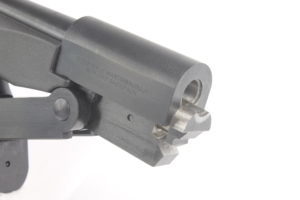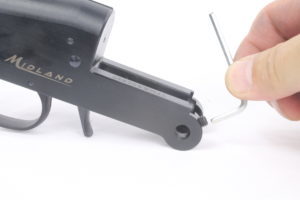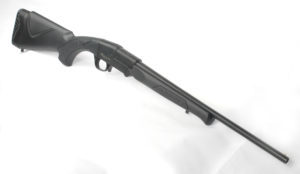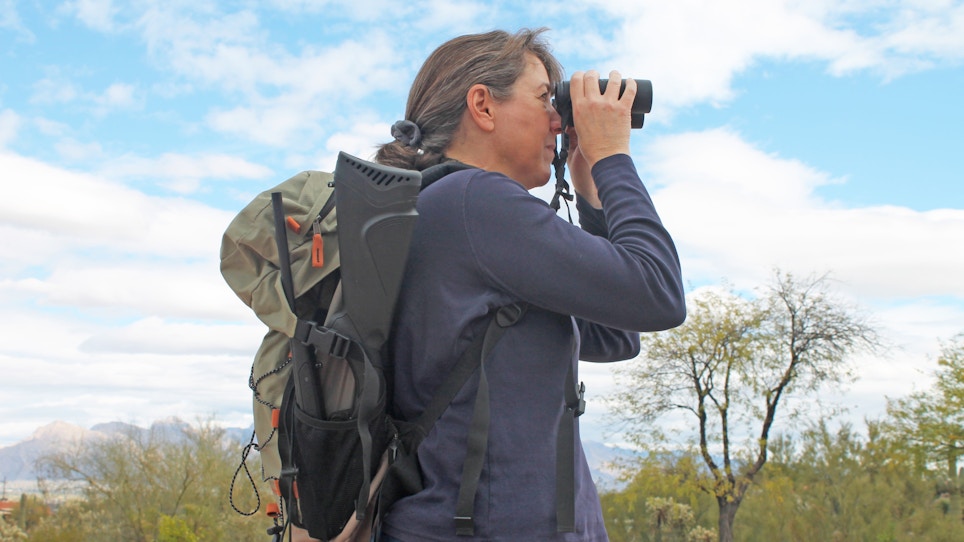True to its name, the single-shot Midland Backpack shotgun folds easily and fits in a backpack. (Photo: Warren Berg)
It’s a pretty sure bet that at some point, single-barrel, break-open shotguns are part of every shooters journey. My cousin Chris had an Ithaca 66 that we shot rabbits and ducks with as kids. As teens, my neighbor Mike had an H&R 12-ga. he used for hunting deer and in the next neighborhood over, Dane’s little brother Dennis carried some ancient single-barrel .410 when we went squirrel hunting. I inherited my grandfather’s 12-ga. Acme Gun Screw Key single-barrel that I converted into a .32-20 Schutzen rifle and my kids cut their teeth in part on a used CBC 20-gauge that I picked up at Clark Bros. for $25.
My point is, break-open, single-barrels are easy sells. They’re inexpensive — sometimes even impulse purchases. People buy them.
But if someone offered a gun in this class with better features but still at a bargain price, would it be an even better seller for dealers?

Breech blocks made on Mazak CNC machines are so precise that Midland can offer barrel interchangeability at the user level. (Photo: Midland)
Val Forgett of Midland Arms is betting on that with the new Midland Backpack shotgun. It offers not only the simplicity and value of a break-open single-barrel, but has advanced features and overcomes many of the deficiencies of legacy designs to make these guns more versatile, safer and easier to use.
“I decided that just offering another low-cost, single-barrel shotgun really wasn't an interesting or compelling way to enter the market,” Forgett said. “It had to be something genuinely different and better.”
Chris and I did great on sitting rabbits along the field edges, but flying ducks or running rabbits were lucky shots at best because of the gun’s fixed full choke. Back then, even more advanced pumps and semi-autos rarely came with changeable choke tubes, but they’re ubiquitous now, which is why Forgett insisted on screw-in tubes as a standard feature for his Midland guns. Both 12- and 20-gauge versions come with modified tubes, and they’re compatible with other Beretta thread pattern tubes for the kind of versatility Chris and I couldn’t choose.
I remember once running into Mike in the woods while deer hunting. To this day, it sticks in my mind that he carried his single-barrel loaded with the hammer cocked. He was about as sneaky as a brick through a window and didn’t think he’d have enough time to thumb back the heavy hammer if he saw a deer. The safety on his gun was the hammer — if it wasn’t cocked, it was on “safe”— so carrying the gun his way was not a safe practice. I knew it then, that’s why it sticks in my mind.
Great Selling Point
A selling point for the Midland is that it has an internal hammer and a simple trigger-blocking safety button in the trigger guard. If Mike had a Midland, he wouldn’t have to worry about thumbing back the hammer much less the danger of carrying it cocked! Just press the safety button as you raise the gun for the shot and it’s ready for action. For added safety, there’s even a visual and tactile cocking indicator on the side of the receiver so shooters and shooting partners can instantly tell the condition of the gun.
Even though Dennis eventually grew into a linebacker-size man, he was a tiny little guy back then and watching him struggle not only against spring resistance but also the coordination of working a top latch while trying to break open his shotgun was comical at times. The grunts and little boy curse words like “dangit” were simply steps in the loading and unloading process.

A simple set screw retains the hinge pin. The Allen wrench is included in the box. (Photo: Midland)
Many single-barrel makers have simplified the coordination by making the latch a button on the tang or in front of the trigger guard where it’s simply a matter of pointing the gun in a safe direction and pressing down the latch. Midland does that, too, by placing the latch in front of the trigger guard, but opening the action simultaneously cocks the internal hammer — something Dennis also struggled with, especially under the pressure of reloading before an angry squirrel scolding him first for missing, and then for just being in the woods.
While that 20-gauge I got for my kids is a beautiful gun, the stock was simply too long. With only $25 invested, I had no qualms about crudely running the buttstock across a table saw and reshaping the solid plastic buttpad on a belt sander. Of course, now that they’re grown, the gun doesn’t fit them and it patterns so tightly that I occasionally use it for turkey hunting. To compensate for the stock amputation, I have to use a slip-on recoil pad stuffed with layers of cardboard to bring the length of pull back up to adult proportions.
Forgett realized that even a single-barrel can grow with a shooter and worked with the manufacturer to come up with a stock spacer system that lets you adjust the length of pull from 12 3/4 to 13 3/4 inches. There’s even a compartment concealed beneath the buttpad for a survival kit that Midland is developing.
Probably every dealer has a “Mike” or “Dennis” or some other experience in their background and can relate to Midland’s improvements. And while all of these are comparatively “advanced” features for the simple single-barrel, they’re just the tip of the iceberg with the Midland.
“Rossi and Traditions guns seemed to be the most popular in the 'combo' package of a shotgun and rimfire barrel fitted to the gun,” Forgett said. “When I began working with the manufacturer, it became apparent their level of machining and quality gave me the ability to offer not just matched pairs, but replacement barrels that were universally interchangeable on any Midland receiver. The reason is that the breech blocks are all identically precision machined on Mazak CNC, as are the receivers. The result is that no matter what barrel is press-fit into the blocks, the exterior dimensions never change.”

Features include a push-button, trigger-blocking safety and visual and tactile cocking indicator. Open the Midland Backpack using the release in front of the trigger guard. (Photo: Midland)
More on the Way
With that kind of universal interchangeability, Midland is developing an entire line of shotgun, rimfire (mid-2018) and centerfire (late-2018) barrels compatible with the basic receiver. “It’s basically an entry-level T/C,” explains Forgett. There are even more features in development including replaceable colored checkering panels (mid-2018) so dealers can outfit Midland Backpack shotguns with athletic team colors and as for that “Backpack” moniker, the Midland Backpack actually folds in half for storage or transportation.
Forgett sent samples of every model Midland Backpack currently in production so I could compare the consistency of manufacturing quality between them. “Frankly, there are other Turkish import shotguns that are cheap, and just suck,” he cautions.
The Midland guns all appear very well made and without any machining marks. Fit and finish are great and changing the barrels between guns is simply a matter of removing a set screw along with the hinge pin and turning out the front sling swivel stud to remove the forend to make the swap. Both 12- and 20-gauge guns come with forend adapters for smaller diameter barrels. Stock spacers are easily added or removed with a Phillips head screwdriver.
Forgett’s ideal dealer is one with a very wide-ranging customer base as it’s an entry-level single-barrel shotgun at a low price; a stocking gun dealer who keeps a real inventory of major brands, buys through first-tier distribution to qualify for terms, discounts, etc. and who can articulate to the customer the features, advantages and benefits of the Midland Backpack.
Midland shotguns are sold exclusively through first-tier distribution; there is no circumvention. Distributors are RSR, Zanders, Bill Hicks and Bangers. Dealer price is $114.95, MSRP is $149.95, MAP is $139.95 and Forgett is not shy about strictly enforcing MAP pricing. While Midland is a new name, the company behind it, Navy Arms, has been around for more than 60 years. Midland guns come with a one-year mechanical warranty and a 30-day cosmetic warranty. Customers can even extend their gun’s mechanical warranty to three years at no charge by simply registering the purchase online with Midland.
Forgett’s message to dealers? “Best features, prices and margins in the category; a branded product with a warranty; only sold through first-tier distribution; enforced MAP to ensure margins; and new product developed, produced and sold by an old-line company.
“It makes money, and sells,” he adds. “Every person who walks into a gun store has $150 to spend on a gun; it’s the cost of taking your family to Outback on Friday night…[Midland] produces repeat customers for barrels, stocks, inserts, chokes, etc., so carrying Midland will lead to incremental sales to the same customer — a hard thing to do with most guns.”






